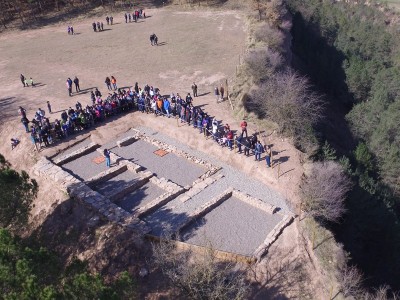Coordinators: Roger Sala, Àngels Pujol and Carles Padrós (ICAC)
Funding institution: 1% Cultural Eix Transversal (CEDINSA) and FEDER
Other participating bodies: Oristà Town Council, Government of Catalonia Archaeology Service, Museum of Archaeology of Catalonia, Sot prospecció Arqueològica, Actium, DIDPATRI (UB) and ICAC.
Web: www.puigciutat.com
Summary
In its final phase, in the 1st century BC, Puig Ciutat was a Roman settlement. As an archaeological site, it has been intensively studied since 2010, when a team of young archaeologists began work there. In the late Republican period, it would have been praesidia or military garrison for the territory. This was a time of considerable instability, with a civil war between Julius Caesar and the followers of Gnaeus Pompeius Magnus (49-45 BC). The site came to a violent end, as evidenced by the remains of throwing weapons and destruction by fire.
Description
Between 2010 and 2013, only a small part of the five hectares of the archaeological site was excavated. A stretch of wall to the east and adjoining habitational structures were documented. In the middle of the plateau, in another field, complex habitational structures with a rich material culture were also excavated. The archaeological site also has two earlier phases, one possibly Iberian (approx. 4th-2nd c. BC), much ravaged by the later Roman occupation, and an earlier Late Bronze Age/First Iron Age (approx. mid-9th-mid-7th c. BC) occupation, which is still largely unknown.

The years 2014 and 2015 saw two major projects. The first was an excavation funded by the 1% Cultural Eix Transversal (CEDINSA) and allowed the south-eastern stretch of the perimeter wall to be revealed, which led to a better understanding of the settlement access system. A second intervention funded by a FEDER project granted to the municipality of Oristà allowed the site to be transformed into a visitable and open access archaeological park, a link between the areas of Oristà and La Torre d’Oristà. This intervention consisted of excavating two uniform spaces to help explain the archaeological site.
On 12 March 2016, the Puig Ciutat archaeological park was inaugurated following the museumisation of the excavated remains, the signposting of the points of interest and the adaptation of the surrounding area. Visitors can take a self-guided tour of the park by following the informative panels and the QR codes placed at strategic points. There is also an archaeological site website with extensive content that allows visitors to tour the virtual museum and see the photogrammetries of the archaeological site.





